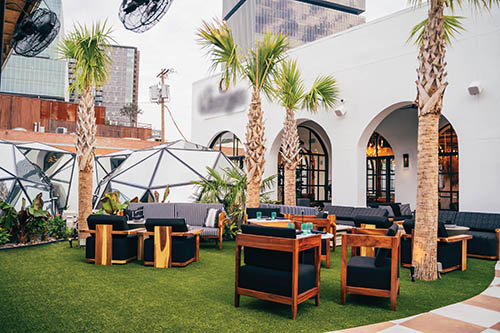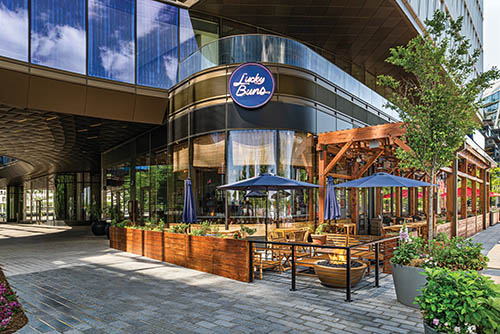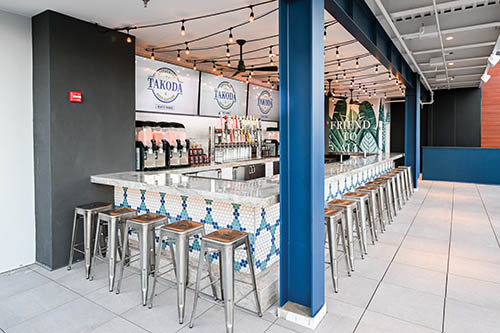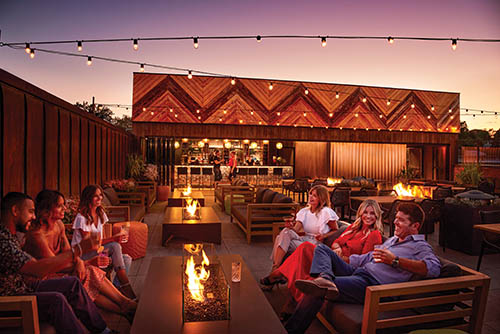— By David Shove-Brown, Robert Ervin & Katy Curtis —
Expert strategies for aesthetic, functional and sustainable spaces.
In recent years, there has been a noticeable shift in dining preferences, with more people gravitating toward outdoor environments rather than traditional indoor atmospheres, largely influenced by the pandemic even years later. This is evident across various settings, from bustling sidewalk cafes to outdoor-themed restaurants and even rooftop gardens and bars. Designing outdoor dining spaces has evolved into an art form that balances aesthetics, functionality and a strong connection with one’s surroundings. As the demand for outside seating surges, restaurants and lounges seek to enhance their appeal with well-designed outdoor spaces.

Three industry leaders share their expertise on creating outdoor dining environments that are not only visually stunning but also operationally efficient and sustainable. By incorporating thoughtful design elements, weatherproofing strategies and biophilic principles, these designers provide valuable guidance on crafting inviting and memorable outdoor dining experiences.
David Shove-Brown
Co-Founder & Principal, //3877
Before committing to an outdoor dining option during the design process, choosing the right location for an outdoor dining area is crucial. Different environments offer unique opportunities and challenges. Rooftops, small patios, expansive rear areas and even converted parking lots can all be effective spaces for outdoor dining, depending on the restaurant’s existing structure and surroundings. Whether it’s existing restaurants looking to carve out dedicated outdoor areas or new builds determining the best location to establish these environments, ensuring these spaces feel intentional and inviting is key to their success long term. Regardless of the setting, striking the correct ambiance is key to attracting and retaining patrons. Diners seek out a memorable experience in addition to good food, requiring outdoor dining to feel like an intentional extension of the interior atmosphere.

Operational functionality is a critical aspect of outdoor dining design that is often overlooked as owners and operators get hung up on aesthetic elements. To create a holistic outdoor dining environment, restaurants must consider how to serve guests efficiently in these spaces. Outdoor areas should be strategically placed within the floor plan to minimize the distance to restrooms and kitchens, ensuring a smooth flow of service for both patrons and employees. It’s important for staff to feel fully equipped to serve outside to maintain a high quality of service throughout the experience. For example, storage solutions for outdoor bars and adaptable server stations with the ability to quickly transition for inclement weather are also key to maintaining operational efficiency.

Outdoor dining design has significantly evolved; it is no longer sufficient to place a few weather-proof chairs and umbrellas outside and call it an experience. Today, the goal is to create an outdoor space that feels like an extension of the indoor dining area by using similar furniture, materials and color schemes that maintain a cohesive look. Larger design selections, such as operable partitions and doors that blur the line between inside and outside are also popular, establishing infrastructure in the building itself to supplement a seamless indoor-outdoor transition. Additional touches such as pillows, rugs, planters, outdoor bars and even TVs enhance the comfort and appeal of these spaces. Making outdoor furniture selections that are as comfortable and aesthetically pleasing as indoor furniture can create a more welcoming environment that invites guests to stay a while and enjoy themselves rather than rush through their meal. Sometimes, we even select outdoor pieces first due to their durability and design versatility, then find coordinating pieces for the inside. This approach ensures that diners enjoy a consistent flow from indoor to outdoor settings, enhancing their overall dining experience.
Furthermore, incorporating biophilic design elements can significantly enhance the outdoor dining experience –– often, this approach is thought of only for interiors, as it’s essentially “bringing the outdoors in,” but sometimes, you even need to connect the outdoors to the outdoors. When making the decision to sit outside, patrons want to feel connected to the outdoors. This involves more than just adding a few plants; it’s about creating a genuine connection to nature. Strategic placement of greenery, such as green walls, and thoughtful use of lighting can transform an outdoor space into a tranquil oasis. Embracing natural views and designing spaces that feel integrated with their surroundings can elevate the dining experience, promoting relaxation and a sense of well-being, while shielding unsightly views, like parking lots, with wood partitions or lush plantings can make diners feel more immersed in the setting.

Robert Ervin
Owner & Principal Architect, Ervin Architecture
Open-air spaces are increasingly integral parts of the hospitality scene, reflecting a broader desire for alfresco dining experiences among modern-day consumers. This represents the opportunity to create multi-layered and multi-purpose atmospheres, as outdoor dining areas can be marketed independently due to their unique environments –– creating a sort of 2-in-1 experience that separates indoor and outdoor while drawing patrons from one to another. When diners choose to sit outside, they still want to experience the whole space. The design question is whether to keep these outdoor spaces overtly unique or create subtle common design themes to bring them into the dialogue while keeping them distinct.

For designers and owners/operators alike, attention to detail is required to ensure the success of an outdoor endeavor. Seemingly minute details to the overall scheme, such as circulation and proximity of seat to table, are important considerations to ensure things run as smoothly as possible. These sorts of designs sometimes overlook the need for waitstaff support components such as napkins, menus, silverware and POS stations in larger patio areas — an error which is hard to correct after all is said and done. These elements prevent waitstaff from constantly running in and out of the interior space, allowing them to coexist more efficiently with patrons and make the outdoor dining environment feel as efficient and enjoyable as possible. Including these components in the design stage ensures a more efficient operational flow, inherently enhancing the guest experience.
Perhaps most obviously, weather considerations also play a vital role in outdoor design. A common issue is the failure to fully recognize the impact of weather conditions holistically. While many designs accommodate rain, there is often insufficient attention given to the effects of intense sunlight. Providing adequate shade is essential, not just for rain protection but also for shielding patrons from the sun’s harsh rays. Showing consideration for a multitude of environmental factors makes your operations prepared to handle any situation, prioritizing the comfort of diners in a way that makes them feel valued and keeps them coming back for more.

Katy Curtis
Owner & Creative Director, 75 Degree Design Studio
Creating an outdoor dining area that feels as comfortable as an indoor space is a growing trend, particularly in the luxury hospitality market. Achieving this residential-level comfort requires careful selection and placement of furniture to ensure both function and aesthetic appeal. Incorporating plush seating, cozy throws and soft lighting can make outdoor spaces feel both luxurious and welcoming. Focusing on the integration of greenery can help create a lush, garden-like ambiance. This can be achieved with a combination of real and faux plants, tailored to the local climate and the owner’s budget. Strategically placed plants not only enhance the beauty of the space but also contribute to a sense of tranquility and privacy.
To ensure outdoor dining spaces are functional throughout the year, weatherproofing is essential. A common mistake in outdoor design is neglecting to plan for varying weather conditions, which can render a space unusable during certain seasons. Incorporating elements such as shade structures, fans, misters, heaters and fireplaces can extend the usability of outdoor areas, providing comfort to guests regardless of the weather.
As sustainability becomes increasingly important in restaurant design, I try to reuse and repurpose furniture and materials as much as possible in my projects. By maximizing the use of existing resources, designers can minimize waste and reduce environmental impact. Although this depends on client budgets, I also recommend investing in high-quality, durable furniture that will last longer and prevent waste down the line. While the initial cost may be higher, quality furniture lasts longer and withstands the elements better, reducing the need for frequent replacements. Look for furniture made from hard-wearing material and upholstered pieces with proper drainage holes. It’s also important that cushions and fabrics are designed to resist fading and mildew. I tend to stay away from materials such as natural teak because of how it grays over time with the sun — instead, a wood such as iroko maintains its color better. There are also so many great faux products available now with technology that you can create outdoor spaces that reflect the residential feel that is so desired without breaking the bank.
In Conclusion
Crafting exceptional outdoor dining spaces requires a harmonious blend of design, functionality and sustainability. Insights from leaders in the field, such as David Shove-Brown, Robert Ervin and Katy Curtis, highlight the importance of intentional design choices, efficient operational planning and the integration of nature to enhance the overall dining experience. By focusing on these key aspects, restaurants and hospitality venues can create outdoor spaces that captivate patrons and provide a seamless extension of indoor dining areas. The result is a vibrant, welcoming environment that not only attracts but also retains guests, ensuring a thriving and sustainable dining experience year-round.
— David Shove-Brown is co-founder and principal of //3877, a design firm committed to providing innovative and creative spaces that enrich the relationships of clients, partners and the communities in which they reside. //3877 has offices in Washington, D.C., and New York City.
— Robert Ervin is owner and principal architect of Ervin Architecture. EA is a commercial and residential architect and interior design team based in Maine and Florida, specializing in entertainment and music venues, custom luxury homes, restaurants and bars, hospitality and more.
— Katy Curtis is owner and creative director of 75 Degree Design Studio, based in Dallas. Specializing in restaurant design, each destination is driven by the concept of the client and the vision is to create unique, evocative experiences.

